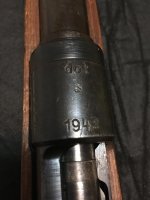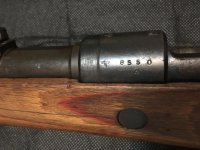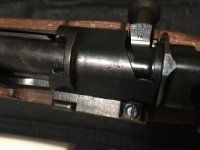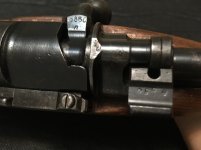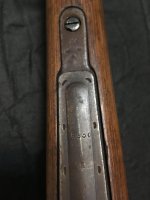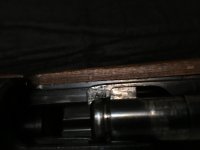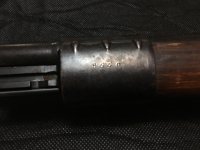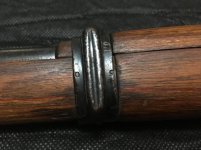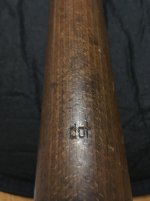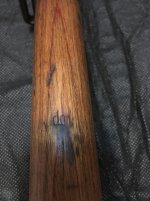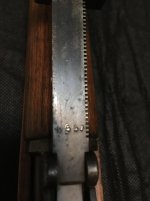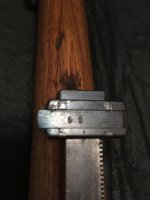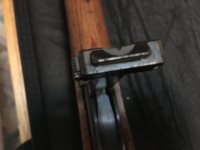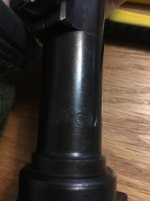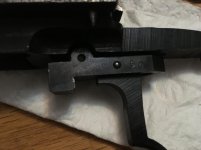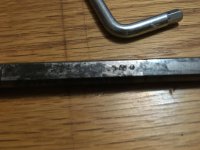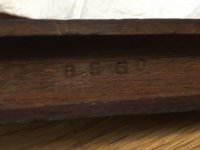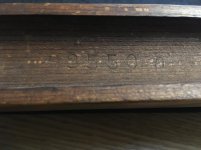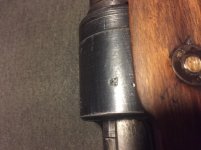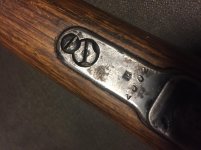
You are using an out of date browser. It may not display this or other websites correctly.
You should upgrade or use an alternative browser.
You should upgrade or use an alternative browser.
dot 43 n block
- Thread starter Ren
- Start date
Bob in OHIO
Senior Member
the unnumbered trig guard, which lack lock screws seems odd for a '43 dot?
Kammerjaeger
Well-known member
Why are there two dot stamps on the wood? One on the keel is correct, but the one that is clearly sanded, what's up with that? And where is it located, hard to tell from photo. Upper handguard interior serial stamp is suspect IMO. Also, I agree with Bob, no capture screws in a dot 43? A bit early IMO.
KJ
KJ
This is correct, the TG should be e/214 / 8550, though the FP looks proper.
As for the stock serialing I say its probably good, - pictures should be better for a proper evaluation though - dot/43 serialed with suffix the internal stock, typically like this. Also typical is "dot" on top of handguard and lower buttstock. While it is true that the internal serial typically is upper case (even when the receiver serial is lower case) this lower case "n" is probably good. In some blocks lower case is used (like the h-block). I do have concerns over the handguard though, more typical it is suffixed also, though I have far too few trends on this feature.
*** rifles before and after this rifle have full serial w/suffix on the handguard, this handguard is bad. So is the TG, probably other things as well.
As for the stock serialing I say its probably good, - pictures should be better for a proper evaluation though - dot/43 serialed with suffix the internal stock, typically like this. Also typical is "dot" on top of handguard and lower buttstock. While it is true that the internal serial typically is upper case (even when the receiver serial is lower case) this lower case "n" is probably good. In some blocks lower case is used (like the h-block). I do have concerns over the handguard though, more typical it is suffixed also, though I have far too few trends on this feature.
*** rifles before and after this rifle have full serial w/suffix on the handguard, this handguard is bad. So is the TG, probably other things as well.
the unnumbered trig guard, which lack lock screws seems odd for a '43 dot?
Kammerjaeger
Well-known member
Also typical is "dot" on top of handguard
I did not know this Loewe, thank you.

KJ
I can't see the stamps on the TG well enough in the pictures to determine if they are both e/135, but assuming that they are, is it possible to have a double stamped TG that is correct on an all matching gun that is not a MO? Sorry to inject this question here, but would like to know if this is ever seen on a depot build or perhaps other configuration. Still in the learning phase and appreciate any thoughts on this topic!!
Ren
Member
I can't see the stamps on the TG well enough in the pictures to determine if they are both e/135, but assuming that they are, is it possible to have a double stamped TG that is correct on an all matching gun that is not a MO? Sorry to inject this question here, but would like to know if this is ever seen on a depot build or perhaps other configuration. Still in the learning phase and appreciate any thoughts on this topic!!
They are double e/135 which is really weird to me. Even the seems matching FP has e/135 rather than e/63. Base on what I know, e/135 only appears on byf, ar and svw.
Ren
Member
This is correct, the TG should be e/214 / 8550, though the FP looks proper.
why it should be e/214? The info I found shows that e/214 is for duv (1940 - 44) and FP for dou (1943)
The "info" you found is why this forum exists, - any idiot can slap together a website and put up unsupported or out of context observations... it take a researcher or an experienced collector to pontificate knowledgeably on a complex subject full of tedious details.
As I have already said, the TG is bad, it came off a Mauser finished rifle.... there is no question of this, - you will find no one who knows anything to disagree with this assessment.
Waffenamt WaA/214 is not BLM (duv), it is the inspector for the area around Lübeck, which includes a number of firms, including a DWM operation and Lubecawerke, the latter is believed to have made these TG's and FP's. BLM also was inspected by WaA214, but it is incidental/unrelated to our discussion here.
It is a simple fact that dot/43 used these e/214 TG during this period and that they used Mauser made e/135 FP's, they simply did, - Mauser had led the development of stamped components technology for small arms, in coordination with its sister firm DWM. This was primarily a project dealing with machine guns, largely conducted in Posen (modern day Poland), but Mauser introduced it to component manufacturer early on, they along with Lubecawerke produced these types of components as early as 1943 for both Brno and Brno II (dou).
To be crystal clear, Brno (dot) started out in 1943 using a light mix of milled TG's, much as dou used in 1942, but quickly dot went to the e/214 stamped TG's, this would quickly become the normal TG dot used throughout 1943 (e/214 stamped TG serialed to the rifle & e/135 FP serialed to the rifle, - I have trended no variation from this pattern throughout 1943 production, except a few milled FP/TG in the first few blocks of production) - and dou generally followed this same trend during 1943, e/214 TG & e/135 FP's, both serialed.
Your TG with "two" e/135 and no serial means it came off a later production byf rifle. Could it be period, possibly, but you will have to talk fast convincing someone when it comes time to sell.
As I have already said, the TG is bad, it came off a Mauser finished rifle.... there is no question of this, - you will find no one who knows anything to disagree with this assessment.
Waffenamt WaA/214 is not BLM (duv), it is the inspector for the area around Lübeck, which includes a number of firms, including a DWM operation and Lubecawerke, the latter is believed to have made these TG's and FP's. BLM also was inspected by WaA214, but it is incidental/unrelated to our discussion here.
It is a simple fact that dot/43 used these e/214 TG during this period and that they used Mauser made e/135 FP's, they simply did, - Mauser had led the development of stamped components technology for small arms, in coordination with its sister firm DWM. This was primarily a project dealing with machine guns, largely conducted in Posen (modern day Poland), but Mauser introduced it to component manufacturer early on, they along with Lubecawerke produced these types of components as early as 1943 for both Brno and Brno II (dou).
To be crystal clear, Brno (dot) started out in 1943 using a light mix of milled TG's, much as dou used in 1942, but quickly dot went to the e/214 stamped TG's, this would quickly become the normal TG dot used throughout 1943 (e/214 stamped TG serialed to the rifle & e/135 FP serialed to the rifle, - I have trended no variation from this pattern throughout 1943 production, except a few milled FP/TG in the first few blocks of production) - and dou generally followed this same trend during 1943, e/214 TG & e/135 FP's, both serialed.
Your TG with "two" e/135 and no serial means it came off a later production byf rifle. Could it be period, possibly, but you will have to talk fast convincing someone when it comes time to sell.
why it should be e/214? The info I found shows that e/214 is for duv (1940 - 44) and FP for dou (1943)
heavy_mech
RKI- Reasonably Knowledgable Individual
..quickly dot went to the e/214 stamped TG's, this would quickly become the normal TG dot used throughout 1943 (e/214 stamped TG serialed to the rifle & e/135 FP serialed to the rifle, - I have trended no variation from this pattern throughout 1943 production, except a few milled FP/TG in the first few blocks of production)..
This continued well into '44 production too. There are several examples in the picture reference section.
Ren
Member
]Waffenamt WaA/214 is not BLM (duv), it is the inspector for the area around Lübeck, which includes a number of firms, including a DWM operation and Lubecawerke, the latter is believed to have made these TG's and FP's. BLM also was inspected by WaA214, but it is incidental/unrelated to our discussion here.
It is a simple fact that dot/43 used these e/214 TG during this period and that they used Mauser made e/135 FP's, they simply did, - Mauser had led the development of stamped components technology for small arms, in coordination with its sister firm DWM. This was primarily a project dealing with machine guns, largely conducted in Posen (modern day Poland), but Mauser introduced it to component manufacturer early on, they along with Lubecawerke produced these types of components as early as 1943 for both Brno and Brno II (dou).
To be crystal clear, Brno (dot) started out in 1943 using a light mix of milled TG's, much as dou used in 1942, but quickly dot went to the e/214 stamped TG's, this would quickly become the normal TG dot used throughout 1943 (e/214 stamped TG serialed to the rifle & e/135 FP serialed to the rifle, - I have trended no variation from this pattern throughout 1943 production, except a few milled FP/TG in the first few blocks of production) - and dou generally followed this same trend during 1943, e/214 TG & e/135 FP's, both serialed.
Still a learner. That's very informative. Thank you!

Just for accuracy, - I should note that dou/43 does have a long period of using milled TG & FP i-block through r-blocks. This isn't reflected in dot/43 production though, but generally both firms followed the prior pattern, generally e/214 TG & e/135 FP, both serialed.
I pulled the trends to confirm my earlier observation and noticed this grouping of milled components.
I pulled the trends to confirm my earlier observation and noticed this grouping of milled components.
Just for accuracy, - I should note that dou/43 does have a long period of using milled TG & FP i-block through r-blocks. This isn't reflected in dot/43 production though, but generally both firms followed the prior pattern, generally e/214 TG & e/135 FP, both serialed.
I pulled the trends to confirm my earlier observation and noticed this grouping of milled components.
This. Brunn I was going full on with the new stamped parts process in 1943, with Mauser techs. I've never seen a dot 1943 with milled tg or bands and I've owned a number of them over the years. As Loewe stated, the triggerguard is a replacement. It should be stamped and numbered to the rifle.
Cheers,
HB




